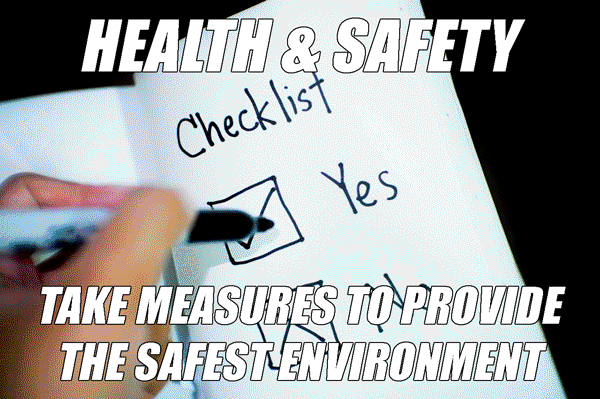Health & Safety Advice & Useful Information
Health and Safety is our business: not just in the sense of compliance to current and relevant legislation, but also the well-being of the people around us. We invest time and resources into our own ongoing education to ensure all health and safety regulations are covered.
By exploring the practical advice, we help companies implement health and safety throughout their organisations in an effective manner.
The Health & Safety Executive
The Health and Safety Executive (HSE) is the national watchdog for work-related health and safety, relating to injuries and illness. Their role is to prevent people from being killed, injured or made ill by work. The HSE work together with businesses to create healthy places of work and to reduce risk.
The HSE website www.hse.gov.uk provides employers, businesses and self-employed people with basic information on what they must do to ensure they comply with health and safety law.
It may surprise you that Health and Safety laws apply to all businesses, no matter how small. All employers and self-employed people are directly responsible for all health and safety in their business. Everyone needs to take the right precautions to reduce the risks of workplace dangers and provide a safe working environment.

Our 10 Point Health & Safety Summary
1) Carry out a risk assessment
Identify any potential hazards and evaluate the extent of the risks to your employees and take appropriate action. A further assessment should be carried out after an accident has occurred.
2) Record your health and safety arrangements
Such arrangements typically include planning, organising, controlling, monitoring and undertaking a review of the ‘protective and preventative measures’ that are in place. You must appoint at least one competent assistant to help you with these tasks.
3) Only employ competent people
You must not employ children under school-leaving age unless their employment is part of an authorised scheme.
4) Create contacts with external services
Compile contact numbers of first aid assistance and emergency medical care for when injuries arise.

5) Provide comprehensive health and safety information to all your employees (including temporary staff)
Inform them of the health and safety risks, the preventative and protective measures in place and the name of your competent assistant. Be aware of communication issues such as language differences.
6) Provide safety arrangements for employees of other companies on your site
Provide appropriate instructions and information.
7) Provide and deliver safety training
Train employees as part of induction, upon transfer to a new job or area or when new equipment is introduced. Keep training records as evidence of this.
8) Your employees
Make sure that your employees let you know of any health and safety shortcomings.
9) Investigate an accident
If an accident occurs, make a record of your findings during your investigation.
10) Keep all records
Log all the above actions taken.
Health & Safety Legislation
The internet holds a wealth of free resources that provide businesses with useful information relating to Health & Safety Law & Risk Assessment. On this page we have listed some of the most useful documents available. Please note that all links will open in a new window.
UK Government Guidance Documents
- Do You Have Paying Guests?
- Fire Safety Risk Assessment: Open-Air Events & Vnues
- Fire Safety Risk Assessment: Transport Premises & Facilities
- Fire Safety Risk Assessment: Healthcare Premises
- Fire Safety Risk Assessment: Residential Care Premises
- Fire Safety Risk Assessment: Theatres, Cinemas & Similar Premises
- Fire Safety Risk Assessment: Factories & Warehouses
- Fire Safety Risk Assessment: Large Places of Assembly
- Fire Safety Risk Assessment: Small & Medium Places of Assembly
- Fire Safety Risk Assessment: Educational Premises
- Fire Safety Risk Assessment: Sleeping Accommodation
- Fire Safety Risk Assessment: Offices & Shops
- Fire Safety Risk Assessment: Means of Escape for Disabled People
- Fire Safety Risk Assessment: 5-Step Checklist
- Fire Safety for People With Sight, Hearing or Mobility Issues
- Regulatory Reform (Fire Safety) Order 2005 – Making Your Premises Safe
- Fire Safety Risk Assessment: 5-Step Checklist
- Fire Safety Risk Assessment: Means of Escape for Disabled People
- Disability: Quick Start Guide for Service Providers
Information on legislation regarding fire and disabilites
- For general information on Health and Safety in the workplace
- For the full Regulatory Reform (Fire Safety) Order 2005
- For information on the Equality Act 2010
For more specific information on disabilities visit:
Disability in the UK Inforgraphic
Evacusafe has released a very useful infographic which highlights some interesting statistics regarding disability in the UK. You may be surprised what you learn. Please click on a link below to view the Infographic in PDF form (link opens in a new window):
